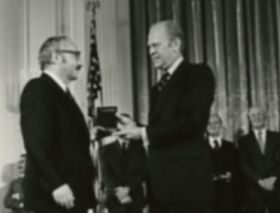George Dantzig | |
|---|---|
 Dantzig with President Gerald Ford in 1976 | |
| Born | George Bernard Dantzig November 8, 1914 Portland, Oregon, US |
| Died | May 13, 2005 (aged 90) |
| Alma mater | University of Maryland (BS) University of Michigan (MS) University of California, Berkeley (PhD) |
| Known for | Linear programming Quadratic programming Stochastic programming Linear complementarity problem Max-flow min-cut theorem of networks Pseudoforest Vehicle routing problem Dantzig's simplex algorithm Dantzig–Wolfe decomposition |
| Awards | John von Neumann Theory Prize (1975) National Medal of Science (1975) Harvey Prize (1985) Harold Pender Award (1995) |
| Scientific career | |
| Fields | Mathematics Operations research Industrial engineering Computer science Economics Statistics |
| Institutions | U.S. Air Force Office of Statistical Control RAND Corporation University of California, Berkeley Stanford University |
| Doctoral advisor | Jerzy Neyman |
| Doctoral students | Robert Fourer Alfredo Noel Iusem Ellis L. Johnson Thomas Magnanti Roger J-B Wets Yinyu Ye |
George Bernard Dantzig (/ˈdæntsɪɡ/; November 8, 1914 – May 13, 2005) was an American mathematical scientist who made contributions to industrial engineering, operations research, computer science, economics, and statistics.
Dantzig is known for his development of the simplex algorithm,[1] an algorithm for solving linear programming problems, and for his other work with linear programming. In statistics, Dantzig solved two open problems in statistical theory, which he had mistaken for homework after arriving late to a lecture by Jerzy Neyman.[2]
At his death, Dantzig was the professor emeritus of Transportation Sciences and Professor of Operations Research and of Computer Science at Stanford University.
- ^ Gass, Saul I. (2011). "George B. Dantzig". Profiles in Operations Research. International Series in Operations Research & Management Science. Vol. 147. pp. 217–240. doi:10.1007/978-1-4419-6281-2_13. ISBN 978-1-4419-6280-5.
- ^ Joe Holley (2005). "Obituaries of George Dantzig". In: Washington Post, May 19, 2005; B06